OAuth 关联类型支持两种业界标准 OAuth 2.0 流程,即隐式和授权代码流程。
在隐式代码流程中,Google 会在用户浏览器中打开您的授权端点。成功登录后,系统会向 Google 返回长期访问令牌。现在,从 Google 助理向你的 Action 发送的每个请求中都包含此访问令牌。
在授权代码流程中,您需要两个端点:
- 授权端点,该端点负责向尚未登录的用户显示登录界面,并以短期授权代码的形式记录所请求的访问。
- 令牌交换端点,负责两种类型的交换:
- 将授权代码交换为长期刷新令牌和短期访问令牌。用户完成帐号关联流程后,系统会进行这种交换。
- 将长期刷新令牌换成短期访问令牌。Google 需要新访问令牌时,由于此令牌已过期,因此会进行此交换。
虽然隐式代码流程的实现更简单,但 Google 建议通过隐式流程发出的访问令牌永远不会过期,因为将令牌过期与隐式流程一起使用会强制用户再次关联其帐号。如果出于安全考虑需要令牌到期,强烈建议您考虑使用身份验证代码流程。
实现 OAuth 账号关联
配置项目
如需将项目配置为使用 OAuth 关联,请按以下步骤操作:
- 打开 Actions 控制台,然后选择要使用的项目。
- 点击开发标签页,然后选择账号关联。
- 启用账号关联旁边的开关。
- 在账号创建部分,选择否,我只想允许在我的网站上创建账号。
在关联类型中,选择 OAuth 和授权代码。
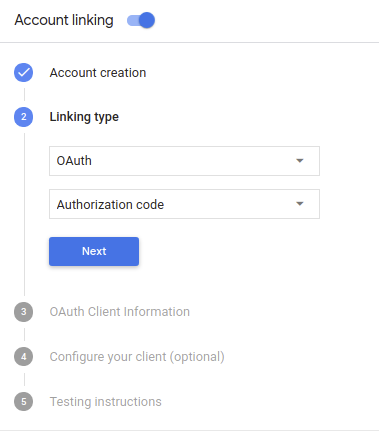
在客户信息中:
- 为 Actions 发给 Google 的客户端 ID 赋值,以标识来自 Google 的请求。
- 记下 Google 为您的操作发布的客户端 ID 的值;
- 插入授权端点和令牌交换端点的网址。
- 点击保存。
实现 OAuth 服务器
授权代码流程的 OAuth 2.0 服务器实现包括 两个端点,您的服务会通过 HTTPS 提供这两个端点。第一个端点 是授权端点,负责查找或获取 就数据访问征求用户意见。授权端点显示登录 尚未登录的用户的界面,并记录同意 请求的访问权限。第二个端点是令牌交换端点, 用于获取名为令牌(用于向 Action 用户授权)的加密字符串 以访问您的服务。
当您的 Action 需要调用您的某项服务的 API 时,Google 会使用这些 API 端点一起获取用户许可,以便在他们的 。
Google 发起的 OAuth 2.0 身份验证代码流程会话包含以下流程:
- Google 会在用户的浏览器中打开您的授权端点。如果流 用户通过纯语音设备启动 Action,Google 会将 将代码执行到手机上
用户登录(如果尚未登录)并授予 Google 以下权限: 通过您的 API 访问其数据。
您的服务会创建授权代码,并通过以下方式返回给 Google: 使用授权代码将用户的浏览器重定向回 Google 附件。
Google 会将授权代码发送到您的令牌交换端点, 验证代码的真实性并返回访问令牌和 刷新令牌。访问令牌是一个短期有效的令牌 作为访问 API 的凭据。刷新令牌长期有效 Google 可以存储该令牌,以便在用户首次访问该令牌时, 过期。
在用户完成账号关联流程后, 从 Google 助理发送到您的 fulfillment webhook 的请求包含 访问令牌。
处理授权请求
当您的 Action 需要通过 OAuth 2.0 授权代码执行账号关联时 流程中,Google 会通过请求将用户发送到您的授权端点 包含以下参数:
| 授权端点参数 | |
|---|---|
client_id |
您在 Google 注册的 Google 客户端 ID。 |
redirect_uri |
此请求的响应发送到的网址。 |
state |
将一个在 重定向 URI。 |
scope |
可选:一组以空格分隔的范围字符串,用于指定 Google 请求授权的数据 |
response_type |
字符串 code。 |
例如,如果您的授权端点可通过 https://myservice.example.com/auth 访问,
请求可能如下所示:
GET https://myservice.example.com/auth?client_id=GOOGLE_CLIENT_ID&redirect_uri=REDIRECT_URI&state=STATE_STRING&scope=REQUESTED_SCOPES&response_type=code
为了让授权端点能够处理登录请求,请执行以下步骤:
验证
client_id与您注册的 Google 客户端 ID 是否一致 并且redirect_uri与 Google 提供的重定向网址相匹配 。这些检查对于防止向 意外或配置错误的客户端应用如果您支持多个 OAuth 2.0 流程,也请确认
response_type为code。检查用户是否已登录您的服务。如果用户没有登录, 完成服务的登录或注册流程。
生成 Google 将用于访问您的 API 的授权代码。 授权代码可以是任何字符串值,但它必须是唯一的 代表用户、令牌对应的客户端以及代码的有效期 而且不可猜测出来。您通常需要进行授权 会在大约 10 分钟后过期。
确认
redirect_uri参数指定的网址 采用以下格式:https://oauth-redirect.googleusercontent.com/r/YOUR_PROJECT_ID
将用户的浏览器重定向到
redirect_uri参数。添加您在 以及您在重定向时返回未经修改的原始状态值 方法是附加code和state参数。下面是一个示例 结果网址:https://oauth-redirect.googleusercontent.com/r/YOUR_PROJECT_ID?code=AUTHORIZATION_CODE&state=STATE_STRING
处理令牌交换请求
您的服务的令牌交换端点负责处理两种令牌 广告交易平台:
- 交换访问令牌和刷新令牌的授权代码
- 用刷新令牌换取访问令牌
令牌交换请求包含以下参数:
| 令牌交换端点参数 | |
|---|---|
client_id |
用于将请求来源标识为 Google 的字符串。此字符串必须 在您的系统中注册为 Google 的唯一标识符。 |
client_secret |
您在 Google 中为您的服务注册的密钥字符串。 |
grant_type |
所交换的令牌的类型。两者之一
authorization_code 或 refresh_token。 |
code |
当 grant_type=authorization_code 时,代码 Google
从您的登录端点或令牌交换端点接收验证码。 |
redirect_uri |
如果值为 grant_type=authorization_code,则此参数为
初始授权请求中使用的网址。 |
refresh_token |
如果值为 grant_type=refresh_token,则刷新令牌 Google
从令牌交换端点接收的令牌 |
交换访问令牌和刷新令牌的授权代码
用户登录且您的授权端点返回短期授权后 代码,Google 就会向您的令牌交换端点发送请求, 访问令牌和刷新令牌的授权码。
对于这些请求,grant_type 的值为 authorization_code,值
code 是您先前向 Google 授予的授权代码的值。
以下是使用授权代码交换
访问令牌和刷新令牌:
POST /token HTTP/1.1 Host: oauth2.example.com Content-Type: application/x-www-form-urlencoded client_id=GOOGLE_CLIENT_ID&client_secret=GOOGLE_CLIENT_SECRET&grant_type=authorization_code&code=AUTHORIZATION_CODE&redirect_uri=REDIRECT_URI
要将授权代码交换为访问令牌和刷新令牌,您的
令牌交换端点响应执行以下步骤的 POST 请求:
- 验证
client_id是否将请求来源标识为已获授权的来源。 并且client_secret与预期值匹配。 - 请验证以下内容:
<ph type="x-smartling-placeholder">
- </ph>
- 授权代码有效且未过期,且客户端 请求中指定的 ID 与 授权代码。
redirect_uri参数指定的网址完全相同 初始授权请求中使用的值。
- 如果您无法验证上述所有条件,则返回 HTTP
正文为
{"error": "invalid_grant"}的 400 Bad Request 错误。 - 否则,使用授权代码中的用户 ID 生成刷新 令牌和访问令牌。这些标记可以是任何字符串值,但它们必须 唯一代表令牌的用户和客户端,不得 更容易被猜到。对于访问令牌,请记录令牌的到期时间 (通常在您发放令牌一小时后)。刷新令牌不会过期。
- 在 HTTPS 响应的正文中返回以下 JSON 对象:
{ "token_type": "Bearer", "access_token": "ACCESS_TOKEN", "refresh_token": "REFRESH_TOKEN", "expires_in": SECONDS_TO_EXPIRATION }
Google 会存储用户的访问令牌和刷新令牌,并记录 访问令牌的过期日期。访问令牌过期后,Google 会使用刷新 令牌,从令牌交换端点获取新的访问令牌。
用刷新令牌换取访问令牌
访问令牌过期后,Google 会向您的令牌交换端点发送请求 将刷新令牌交换为新的访问令牌。
对于这些请求,grant_type 的值为 refresh_token,值
refresh_token 是您之前授予 Google 的刷新令牌的值。
以下是用刷新令牌交换
访问令牌:
POST /token HTTP/1.1 Host: oauth2.example.com Content-Type: application/x-www-form-urlencoded client_id=GOOGLE_CLIENT_ID&client_secret=GOOGLE_CLIENT_SECRET&grant_type=refresh_token&refresh_token=REFRESH_TOKEN
如需将刷新令牌交换为访问令牌,令牌交换端点
对执行以下步骤的 POST 请求做出响应:
- 验证
client_id是否将请求来源标识为 并且client_secret与预期 值。 - 请确认刷新令牌有效,以及在 请求与刷新令牌所关联的客户端 ID 相匹配。
- 如果您无法验证上述所有条件,则返回 HTTP
正文为
{"error": "invalid_grant"}的 400 Bad Request 错误。 - 否则,请使用刷新令牌中的用户 ID 来生成访问权限 令牌。这些标记可以是任何字符串值,但它们必须唯一地表示 令牌对应的用户和客户端,并且不得被猜到。 对于访问令牌,请记录令牌的到期时间 (通常在您发放令牌一小时后)。
- 在 HTTPS 的正文中返回以下 JSON 对象
回答:
{ "token_type": "不记名", "access_token": "ACCESS_TOKEN", “expires_in”:SECONDS_TO_EXPIRATION }
为身份验证流程设计语音界面
检查用户是否已通过验证,并启动账号关联流程
- 在 Actions 控制台中打开您的 Actions Builder 项目。
- 创建新场景以在您的 Action 中启动账号关联:
- 点击场景。
- 点击添加 (+) 图标以添加新场景。
- 在新创建的场景中,点击条件的添加 add 图标。
- 添加一个条件,用于检查与对话关联的用户是否为已验证的用户。如果检查失败,您的 Action 将无法在对话期间执行账号关联,并且应回退到提供无需账号关联的功能。
- 在条件下的
Enter new expression字段中,输入以下逻辑:user.verificationStatus != "VERIFIED" - 在过渡下,选择不需要关联账号的场景,或选择仅限访客使用的功能的入口点场景。
- 在条件下的
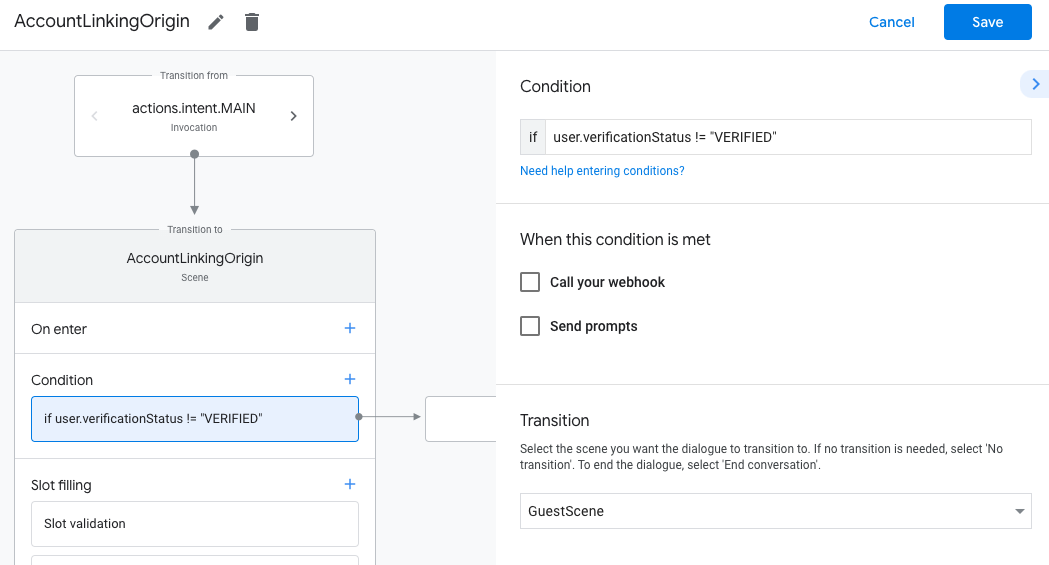
- 点击条件对应的添加 add 图标。
- 添加一个条件,以便在用户没有关联身份时触发账号关联流程。
- 在条件下的
Enter new expression字段中,输入以下逻辑:user.verificationStatus == "VERIFIED" - 在过渡下,选择账号关联系统场景。
- 点击保存。
- 在条件下的
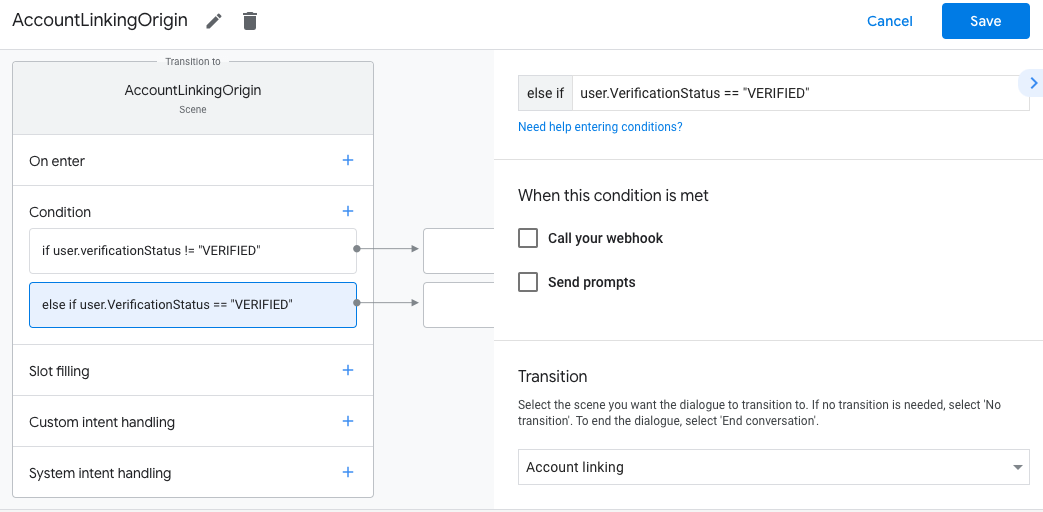
保存后,系统会在您的项目中添加一个名为 <SceneName>_AccountLinking 的新账号关联系统场景。
自定义账号关联场景
- 在场景下,选择账号关联系统场景。
- 点击发送提示,然后添加简短的句子,向用户说明该操作需要访问其身份信息的原因(例如“保存您的偏好设置”)。
- 点击保存。
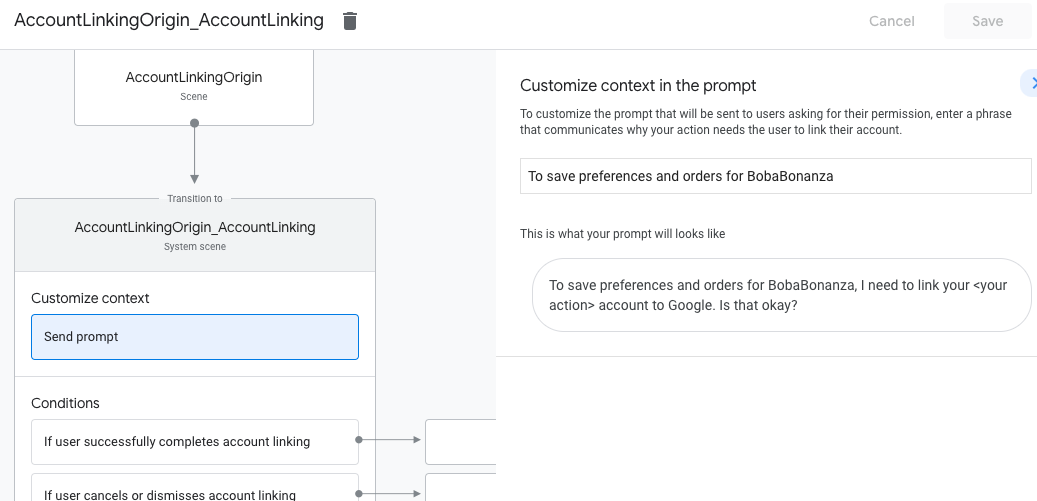
- 在条件下,点击如果用户成功完成账号关联。
- 配置用户同意关联账号后,流程应如何继续。 例如,调用网络钩子来处理所需的任何自定义业务逻辑,然后转换回原始场景。
- 点击保存。
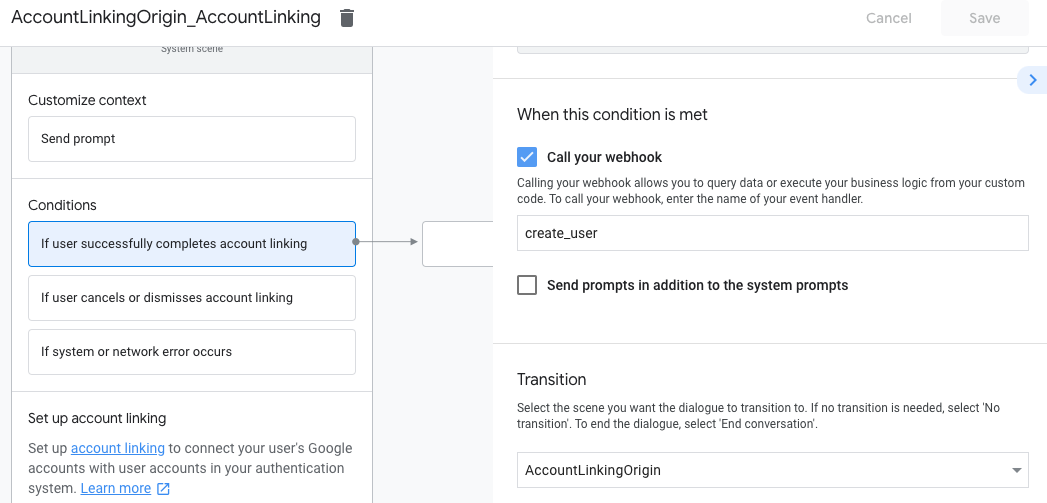
- 在条件下,点击如果用户取消或关闭账号关联。
- 配置用户不同意关联账号时流程应如何继续。例如,发送确认消息并重定向到提供不需要关联账号的功能的场景。
- 点击保存。
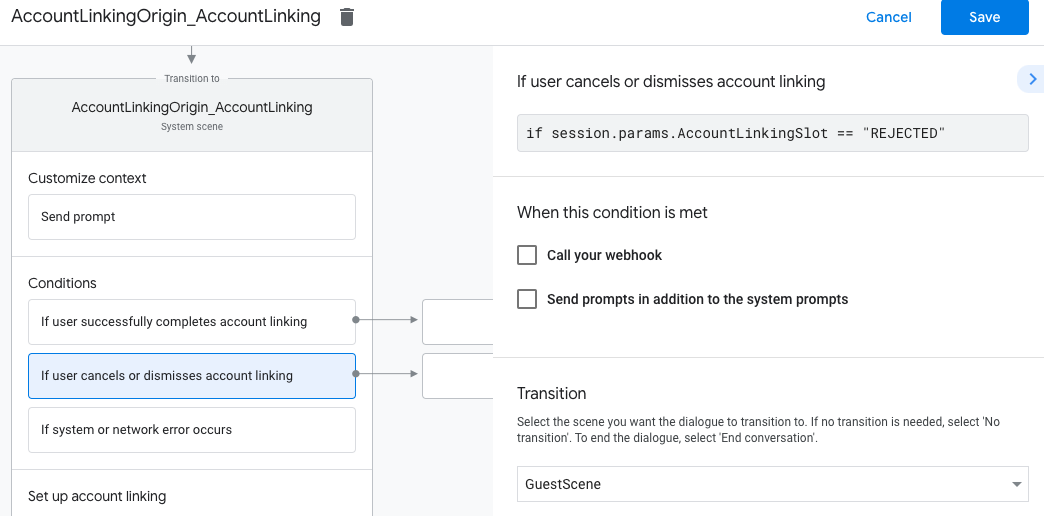
- 在条件下,点击如果发生系统或网络错误。
- 配置在因系统或网络错误而无法完成账号关联流程时,流程应如何继续。 例如,发送确认消息并重定向到提供不需要关联账号的功能的场景。
- 点击保存。
处理数据访问请求
如果辅助功能请求包含访问令牌,请先检查该访问令牌是否有效(未过期),然后从数据库中检索关联的用户账号。

